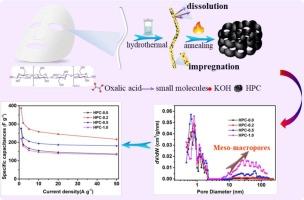Rational engineering of meso-macroporous structured carbon materials for revealing capacitive mechanism
IF 8.9
2区 工程技术
Q1 ENERGY & FUELS
引用次数: 0
Abstract
The tailorable meso-macroporous structure of hierarchical porous carbon (HPC) is an essential key to improve ion diffusion dynamics and microporous accessibility for capacitive material. However, few studies focus on the capacitive mechanism of meso-macroporous proportion of HPC. Herein, a regionally selective dissolution and pyrolysis strategies are deployed to tailor the proportion of meso-macropores in facial mask-derived HPC through adjusting the oxalic acid concentration in hydrothermal process in this contribution. The obtained HPC show increasing meso-macroporous volumes of 0.04, 0.12, and 0.40 cm3 g−1, corresponding to the oxalic acid concentrations of 0.2, 0.5, and 1.0 g/50 ml, respectively, while the microporous structures remain similar. Electrochemical results show that with increasing proportion of meso-macropores, the specific capacitances of HPC decrease from 386.9 to 276.5 and 220.3 F g−1 at current density of 1 A g−1, and decrease from 216.7 to 181.1, and 133.1 F g−1 at 50 A g−1. CV fitting results indicate that a small number of meso-macropores can enhance the surface-controlled capacitive contribution, improving the accessibility of micropores and faradaic pseudocapacitive reactions. The optimized HPC-based supercapacitor delivers a high energy density of 11.5 Wh kg−1 at a power density of 125 W kg−1 in KOH electrolyte and a maximum energy density of 49.4 Wh kg−1 at 225 W kg−1 in Na2SO4 electrolyte with long cycle stability, suggesting that the rational engineering of meso-macroporous proportion in HPC uncover news insights into developing high performance supercapacitor.

揭示电容机理的介孔结构碳材料的合理工程设计
分层多孔碳(HPC)可定制的中-大孔结构是改善电容材料离子扩散动力学和微孔可及性的关键。然而,很少有研究关注 HPC 中介孔比例的电容机制。本文采用区域选择性溶解和热解策略,通过调整水热过程中草酸的浓度来定制面罩衍生 HPC 中的中-微孔比例。所获得的 HPC 的中-大孔体积分别为 0.04、0.12 和 0.40 cm3 g-1,与 0.2、0.5 和 1.0 g/50 ml 的草酸浓度相对应,而微孔结构保持相似。电化学结果表明,随着中微孔比例的增加,在电流密度为 1 A g-1 时,HPC 的比电容从 386.9 F g-1 降低到 276.5 F g-1 和 220.3 F g-1,在电流密度为 50 A g-1 时,比电容从 216.7 F g-1 降低到 181.1 F g-1 和 133.1 F g-1。CV 拟合结果表明,少量中微孔可以增强表面控制的电容贡献,改善微孔的可及性和法拉第伪电容反应。优化后的基于 HPC 的超级电容器在 KOH 电解液中的功率密度为 125 W kg-1 时可提供 11.5 Wh kg-1 的高能量密度,在 Na2SO4 电解液中的功率密度为 225 W kg-1 时可提供 49.4 Wh kg-1 的最大能量密度,并且具有长循环稳定性。
本文章由计算机程序翻译,如有差异,请以英文原文为准。
求助全文
约1分钟内获得全文
求助全文
来源期刊

Journal of energy storage
Energy-Renewable Energy, Sustainability and the Environment
CiteScore
11.80
自引率
24.50%
发文量
2262
审稿时长
69 days
期刊介绍:
Journal of energy storage focusses on all aspects of energy storage, in particular systems integration, electric grid integration, modelling and analysis, novel energy storage technologies, sizing and management strategies, business models for operation of storage systems and energy storage developments worldwide.
文献相关原料
公司名称
产品信息
阿拉丁
Potassium hydroxide
阿拉丁
Ethanol
阿拉丁
Oxalic acid
 求助内容:
求助内容: 应助结果提醒方式:
应助结果提醒方式:


